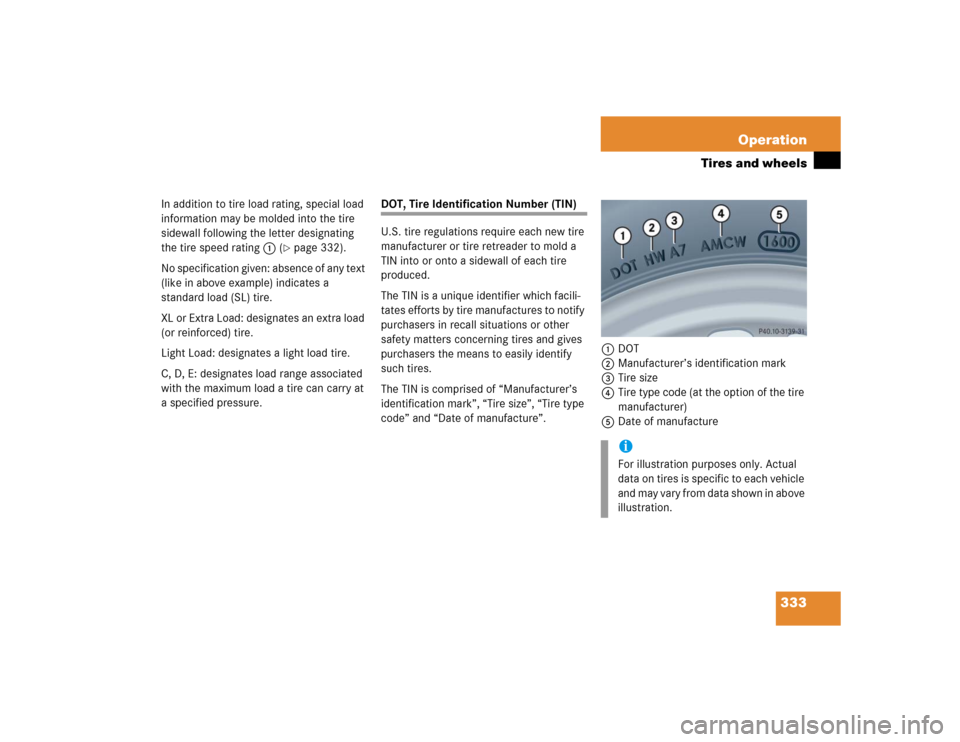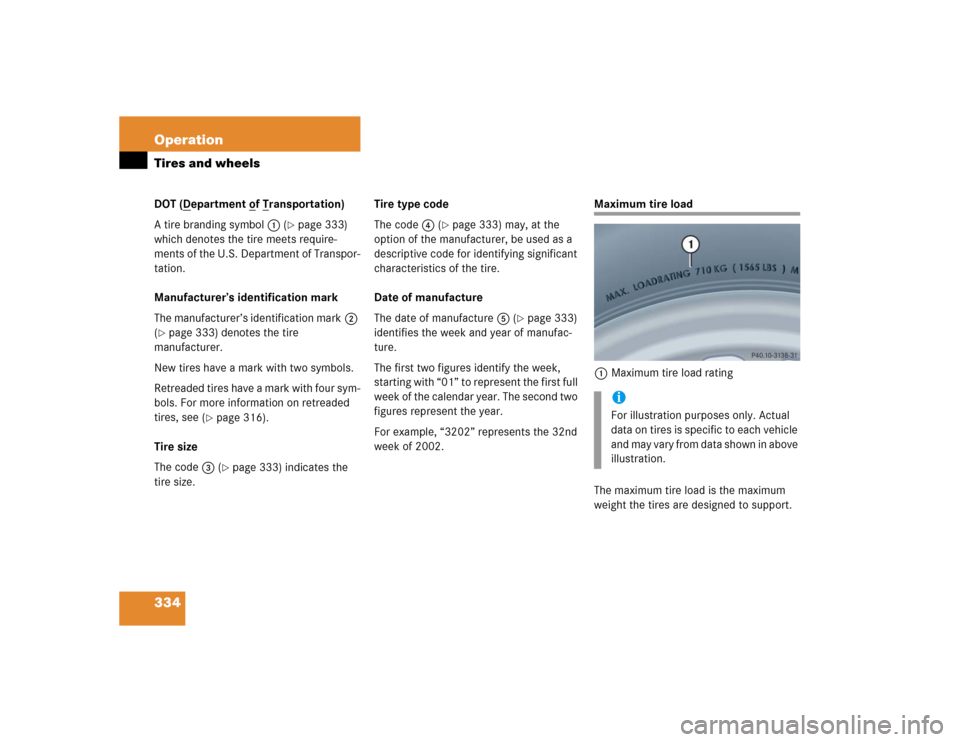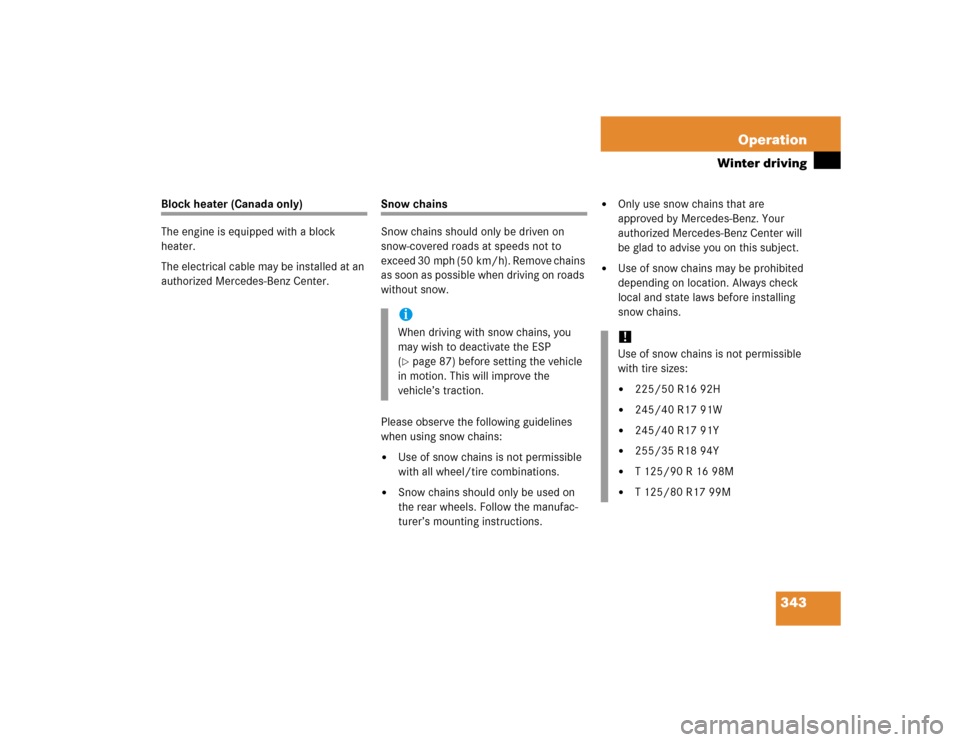Page 334 of 498
332 OperationTires and wheels�
Any tire with a speed capability above
186 mph (300 km/h) must include a
“ZR” in the size designation AND the
service description must be placed in
parenthesis. Example: 275/40 ZR 18
(99Y). The “(Y)” speed rating in paren-
thesis designates the maximum speed
capability of the tire as being above
186 mph (300 km/h). Consult the tire
manufacturer for the actual maximum
permissible speed of the tire.All-season and winter tires
Load identification
1Load identification
Index
Speed rating
QM+S
up to 100 mph (160 km/h)
TM+S
up to 118 mph (190 km/h)
HM+S
up to 130 mph (210 km/h)
VM+S
up to 149 mph (240 km/h)
iThe marking “M+S” next to the service
description designates tires with mud
and snow capabilities.
iFor illustration purposes only. Actual
data on tires is specific to each vehicle
and may vary from data shown in above
illustration.
Page 335 of 498

333 Operation
Tires and wheels
In addition to tire load rating, special load
information may be molded into the tire
sidewall following the letter designating
the tire speed rating1 (
�page 332).
No specification given: absence of any text
(like in above example) indicates a
standard load (SL) tire.
XL or Extra Load: designates an extra load
(or reinforced) tire.
Light Load: designates a light load tire.
C, D, E: designates load range associated
with the maximum load a tire can carry at
a specified pressure.
DOT, Tire Identification Number (TIN)
U.S. tire regulations require each new tire
manufacturer or tire retreader to mold a
TIN into or onto a sidewall of each tire
produced.
The TIN is a unique identifier which facili-
tates efforts by tire manufactures to notify
purchasers in recall situations or other
safety matters concerning tires and gives
purchasers the means to easily identify
such tires.
The TIN is comprised of “Manufacturer’s
identification mark”, “Tire size”, “Tire type
code” and “Date of manufacture”.1DOT
2Manufacturer’s identification mark
3Tire size
4Tire type code (at the option of the tire
manufacturer)
5Date of manufacture
iFor illustration purposes only. Actual
data on tires is specific to each vehicle
and may vary from data shown in above
illustration.
Page 336 of 498

334 OperationTires and wheelsDOT (D
epartment o
f T
ransportation)
A tire branding symbol1 (
�page 333)
which denotes the tire meets require-
ments of the U.S. Department of Transpor-
tation.
Manufacturer’s identification mark
The manufacturer’s identification mark2
(
�page 333) denotes the tire
manufacturer.
New tires have a mark with two symbols.
Retreaded tires have a mark with four sym-
bols. For more information on retreaded
tires, see (
�page 316).
Tire size
The code3 (�page 333) indicates the
tire size.Tire type code
The code4 (
�page 333) may, at the
option of the manufacturer, be used as a
descriptive code for identifying significant
characteristics of the tire.
Date of manufacture
The date of manufacture5 (
�page 333)
identifies the week and year of manufac-
ture.
The first two figures identify the week,
starting with “01” to represent the first full
week of the calendar year. The second two
figures represent the year.
For example, “3202” represents the 32nd
week of 2002.
Maximum tire load
1Maximum tire load rating
The maximum tire load is the maximum
weight the tires are designed to support.
iFor illustration purposes only. Actual
data on tires is specific to each vehicle
and may vary from data shown in above
illustration.
Page 342 of 498

340 OperationTires and wheelsTIN (T
ire I
dentification N
umber)
Unique identifier which facilitates efforts
by tire manufacturers to notify purchasers
in recall situations or other safety matters
concerning tires and gives purchases the
means to easily identify such tires. The TIN
is comprised of “Manufacturer’s identifica-
tion mark”, “Tire size”, “Tire type code”
and “Date of manufacture”.
Tire load rating
Numerical code associated with the
maximum load a tire can support.
Tire ply composition and material used
This indicates the number of plies or the
number of layers of rubber-coated fabric in
the tire tread and sidewall. Tire manufac-
turers also must indicate the ply materials
in the tire and sidewall, which include
steel, nylon, polyester, and others.Tire speed rating
Part of tire designation; indicates the
speed range for which a tire is approved.
Traction
Force exerted by the vehicle on the road
via the tires. The amount of grip provided.
Tread
The portion of a tire that comes into
contact with the road.
Treadwear indicators
Narrow bands, sometimes called
“wear bars” that show across the tread of
a tire when only
1/6in (1.6 mm) of tread
remains.Uniform Tire Quality Grading Standards
A tire information system that provides
consumers with ratings for a tire's traction,
temperature and treadwear. Ratings are
determined by tire manufacturers using
government testing procedures. The
ratings are molded into the sidewall of the
tire.
Vehicle capacity weight
Rated cargo and luggage load plus
68 kilograms (150 lbs) times the vehicle’s
designated seating capacity.
Vehicle maximum load on the tire
Load on an individual tire that is
determined by distributing to each axle its
share of the maximum loaded vehicle
weight and dividing it by two.
Page 343 of 498

341 Operation
Tires and wheels
Rotating tires
Tire rotation can be performed on vehicles
with tires of the same dimension all
around. If your vehicle is equipped with
tires of the same dimension all around,
tires can be rotated, observing a a
front-to-rear rotation pattern that will
maintain the intended rotation (spinning)
direction of the tire (
�page 319).
In some cases, such as when your vehicle
is equipped with mixed-size tires (different
tire dimension front vs. rear), tire rotation
is not possible.If applicable to your vehicle’s tire configu-
ration, tires can be rotated according to
the tire manufacturer’s recommended in-
tervals in the tire manufacturer’s warranty
pamphlet located in your vehicle literature
portfolio. If none is available, tires should
be rotated every 3 000 to 6 000 miles
(5 000 to 10 000 km), or sooner if neces-
sary, according to the degree of tire wear.
The same rotation (spinning) direction
must be maintained (
�page 319).
Rotate tires before the characteristic tire
wear pattern becomes visible (shoulder
wear on front tires and tread center wear
on rear tires).
Thoroughly clean the mounting face of
wheels and brake disks, i.e. the inner side
of the wheels/tires, during each rotation.
Check for and ensure proper tire inflation
pressure.For information on wheel change, see the
“Practical hints” section (
�page 389) and
(
�page 412).
Warning!
G
Rotate front and rear wheels only if the tires
are of the same dimension.
If your vehicle is equipped with mixed-size
tires (different tire dimensions front vs.
rear), tire rotation is not possible.
Warning!
G
Have the tightening torque checked after
changing a wheel. Wheels could become
loose if not tightened with a torque of
80 lb-ft (110 Nm).
Only use genuine Mercedes-Benz wheel
bolts specified for your vehicle’s rims.
Page 345 of 498

343 Operation
Winter driving
Block heater (Canada only)
The engine is equipped with a block
heater.
The electrical cable may be installed at an
authorized Mercedes-Benz Center.
Snow chains
Snow chains should only be driven on
snow-covered roads at speeds not to
exceed 30 mph (50 km/h). Remove chains
as soon as possible when driving on roads
without snow.
Please observe the following guidelines
when using snow chains:�
Use of snow chains is not permissible
with all wheel/tire combinations.
�
Snow chains should only be used on
the rear wheels. Follow the manufac-
turer’s mounting instructions.
�
Only use snow chains that are
approved by Mercedes-Benz. Your
authorized Mercedes-Benz Center will
be glad to advise you on this subject.
�
Use of snow chains may be prohibited
depending on location. Always check
local and state laws before installing
snow chains.
iWhen driving with snow chains, you
may wish to deactivate the ESP
(�page 87) before setting the vehicle
in motion. This will improve the
vehicle’s traction.
!Use of snow chains is not permissible
with tire sizes:�
225/50 R16 92H
�
245/40 R17 91W
�
245/40 R17 91Y
�
255/35 R18 94Y
�
T 125/90 R 16 98M
�
T 125/80 R17 99M
Page 442 of 498
440 Technical dataRims and tiresSame size tires
16" tires
17" tires
CLK 320
CLK 500
CLK 320 (Appearance Package)
CLK 55 AMG
Rims (light alloy)
7J x 16 H2
-
-
Wheel offset
1.45 in (37 mm)
-
-
Winter tires (radial-ply
tires)
205/55 R16 91H M+S
-
-
CLK 320 (Appearance Package)
CLK 500
CLK 55 AMG
Rims (light alloy)
71/2 J x 17 H2
71/2 J x 17 H2
71/2 Jx17H2
Wheel offset
1.42 in (36 mm)
1.45 in (37 mm)
1.45 in (37 mm)
Winter tires (radial-ply
tires)
225/45 R17 91 H M+S
225/45 R17 91 H M+S
225 / 45 R17 91 H M+S
Page 443 of 498
441 Technical data
Rims and tires
Mixed size tires
CLK 320
CLK 320 (Appearance Package)
CLK 500
Front axle:Rims (light alloy)
7 J x 16 H2
71/2 J x 17 H2
71/2 J x 17 H2
Wheel offset
1.45 in (37 mm)
1.42 in (36 mm)
1.45 in (37 mm)
1
1Applies to AMG wheel onlySummer tires
(radial-ply tires)
-
225/45 R17 91W
225/45 ZR17 91Y
All-season tires
(radial-ply tires)
205/55 R16 91H M+S
-
-
Rear axle:Rims (light alloy)
8 J x 16 H2
81/2 J x17 H2
81/2 J x17 H2
Wheel offset
1.26 in (32 mm)
1.18 in (30 mm)
1.18 in (30 mm)
Summer tires (radial-ply
tires)
-
245/40 R17 91W
2
2Must not be used with snow chains.
245/40 ZR17 91Y
2
All-season tires
(radial-ply tires)
225/50 R16 92H M+S
2
-
-